If you spend any time in the woods whatsoever, you need to know how to survive being lost in the woods. At any time, even the most skilled hiker or hunter can lose his or her bearings and suddenly become lost. In the event that such an incident occurs, the individual will need to do everything he or she can to survive, perhaps for hours or even days, before either finding one’s way back home or encountering search rescuers.
[the_ad_placement id=”in-text-1-type-r”]Here you will find tips on how to survive being lost in the woods, should such an event happen to you.
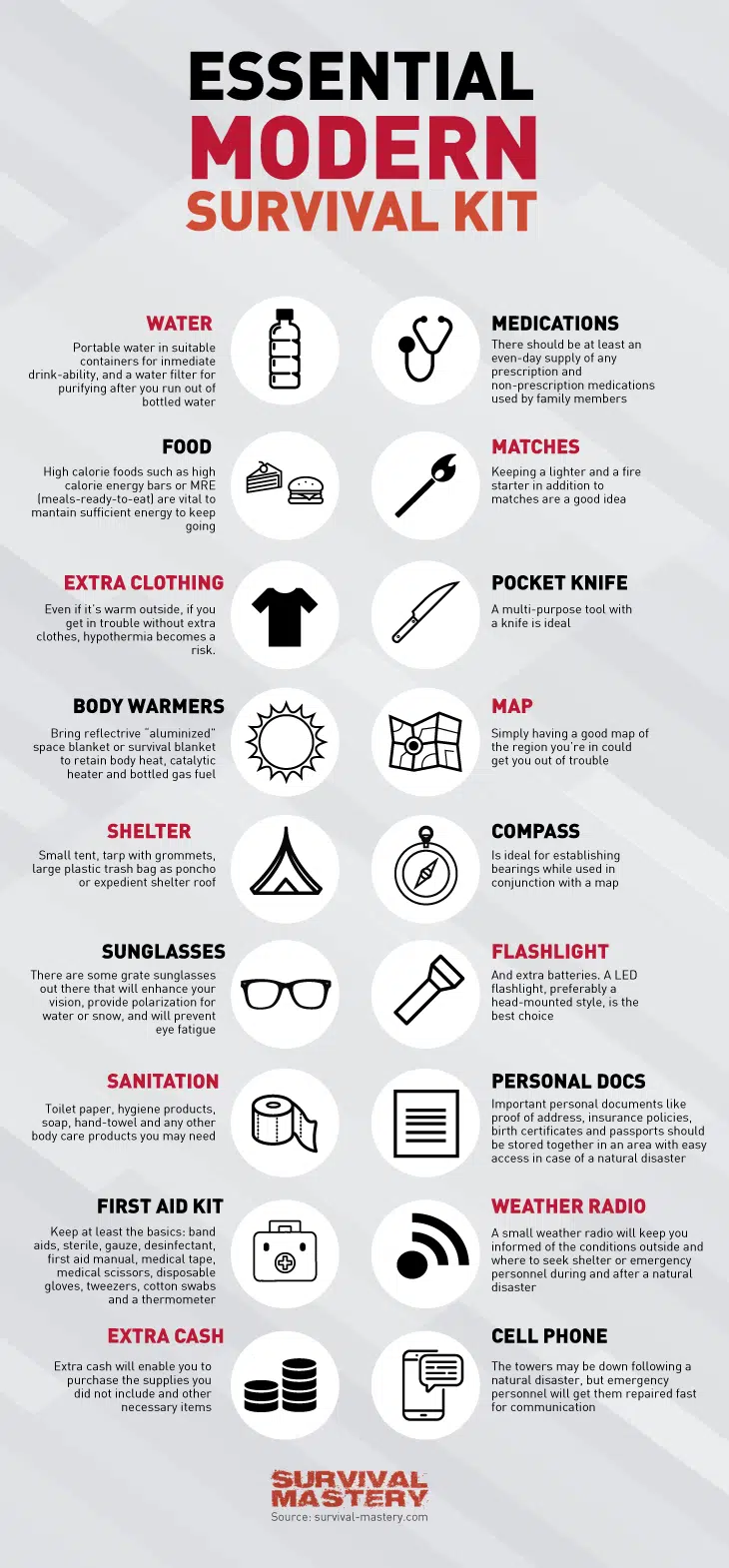
These tips are ideal for adults, but are also something every parent should teach their children as well.
Before entering the woods
Before even entering a wooded area, you should prepare a survival kit that you can bring with you in the event an emergency arises. The kit needs to include, at minimum, all of the following:
- Lighter or strike anywhere matches for the purposes of fire starting.
- A magnifying glass serves as an additional fire starter.
- A ball of dryer lint works as an excellent fire starter.
- Steel wool for fire starting.
- A cup for drinking water.
- A knife for hunting and protection.
- Compass attuned to magnetic north.
- Whistle for getting help.
- Chlorine tablets for water purification.
- Flashlight for seeing at night.
- A pack of extra batteries for the flashlight.
- Trail mix is a great food source with lots of protein.
- Dehydrated food is light to carry and will give you the protein your body needs for fuel.
- Water canteen or several bottles of water.
- A roll of toilet paper.
- Mini-first aid kit for caring for injuries.
- Hat and socks: These two items are really essentials. As much as 70 percent of your body heat escapes your body through your head and feet.
If you are wise, before you leave the home and head out into the woods alone, you should definitely let someone know where you are going and how long you plan to be gone.

By letting someone know where you are going, the likelihood of a more expeditious rescue is great.
More emergency prep items
If you are going on a hike, you can bring a backpack along with you. Doing so will allow you to carry more survival items, just in case you should need them. Additional survival items that can serve you well in an emergency include, but are not limited to, the following:
- Mini pan or mini saucepan for boiling water and cooking.
- 1-2 tin cans (in lieu of a mini pan for boiling water).
- An orange vest that you can wear so you are more visible to search and rescue members.
- Extra layer of clothing to keep warm in the cooler hours of the evening.
- Orange fabric cut into foot long strips are something you can use to tie around nearby trees. It serves as a marker of where you have been and may alert rescuers of your whereabouts or that you have been in the vicinity.
- Small mirror to serve as a reflector for signaling for help.
- Utensils for eating. A large spoon can double as a small shovel for digging holes in the ground that you can use for capturing rainwater.
- Trash bags for disposal of trash. Having the bags will ensure you can prevent attracting animals from any rubbish you might create. Trash bags, when cut, can double as an emergency rain poncho.
Getting lost scenario
If you think because you have hiked in the woods before it is impossible to get lost, think again. Even skilled hikers have gotten lost, especially if the hikers take off on a never traversed trail or enter into an unfamiliar area. Imagine a scenario where you have lost your way, your cell phone signal is non-existent, and you have as little as 1% charge left on your mobile device. You brought a compass with you, but did not set it to magnetic north so now it does not work correctly. It’s mid afternoon, you do not know where you are, and it will be dark within a matter of hours. See our post on the best compass watches to guide you on your way.
At first, you are shocked by the realization that you have become lost in the woods, and may even deny that you are, thinking if you look a bit harder, you will find your way back, and that when you do, you will have a funny story to tell. Then the realization takes another turn and stirs a panic deep within you.

Image credit: hollywoodreporter.com
You attempt to backtrack, looking for familiar landmarks, but everything starts to look the same. Soon you find you are merely going around in circles. Another hour has passed, and the sunset draws near. What are you going to do? The above scenario is a real possibility. Nevertheless, when it comes to figuring out how to survive being lost in the woods there are plenty of things you can do to ensure your survival.
Assess your situation
That sense of panic that sets in when you realize you are lost is the first thing you have to get under your control. You cannot think clearly or assess your current situation if you are in a panicked state. Take a moment to clear your thoughts, breathe, and relax as much as possible. Once you calm yourself, you can begin to take the next steps you need to take to ensure your survival.
[the_ad_placement id=”in-text-2-type-r”]If you have a survival kit, then you are ahead of the game. You have all the things you need to survive in the woods. However, if you have left home without survival equipment, you are going to have to make due with what you do have with you and what you can find around you in the natural environment.
Check, your pockets, wallet, fanny pack, or whatever you are toting with you to see what you might have in terms of resources. Look to see if you have a knife, lighter, matches, or anything else that you can convert into a resource for your survival.
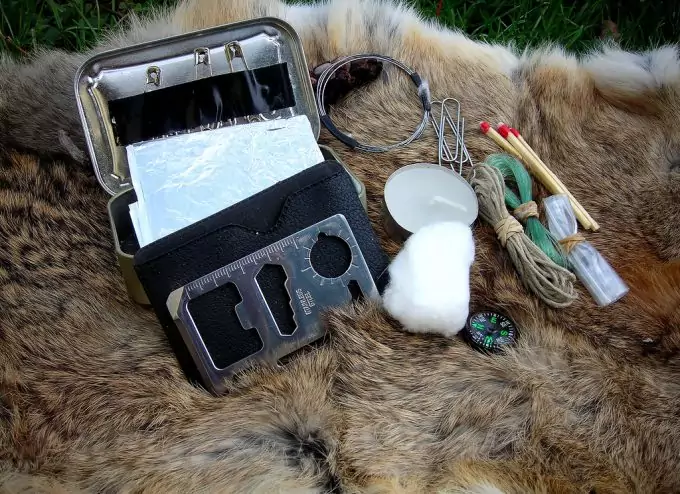
Once you find out if you have any available resources, it is time to make a plan of action. You should always plan for a long-term stay in the woods, as you never know how long it will take for someone to find you or for you to find civilization. Your goal now is to find a water source, start a fire, and build a shelter before taking further action.
Discovering a water source
You have to find water immediately. Look nearby for small pools of water. Dig holes in the ground to collect rainwater if necessary, or if you find large leaves, you can use them to capture water or to get the due water off them. If you have a plastic bag with you, use the bag to line the inside of the hole you dig: This will help you keep the rain water you collect clean.
You can also use the plastic bag to create solar water still for water collection. Put a hole in the soil. Put a small container to put inside the hole. If you do not have one, use another plastic bag. Use wet moss and leaves to put inside the air gaps around the bag or container. Place another bag over the container or bag inside the hole and pin it down with some rocks: water will form through the process of condensation.
You cannot survive without water for more than three to four days. Searching for water is essential to your survival. Look for a river, stream, lakes, or small pond to get drinking water from, but do not drink it straight from the body of water. It is ill advised to drink any water source in the woods without boiling it first. If you have a can, you can use it for the purposes of boiling water.
Fire building
Before establishing a shelter, you need a fire, not just to keep warm, but also to cook with and for the purposes of water purification. You must always boil water before drinking it, no matter what the source when you are lost in the woods. There are myriad methods for starting a fire including:
Use your emergency resources if you have them: You can start a fire using the steel wool, lint, magnifying glass, lighter or strike anywhere matches in your survival kit.
If you have no fire-starting equipment with you: If you have eyeglasses, you can use your glasses to start a fire with some dry leaves. Alternatively, you can use two sticks and cause friction by rubbing the sticks together. If you have a knife on hand, you can also scratch the blade of your knife on a rock to get sparks for igniting a fire.
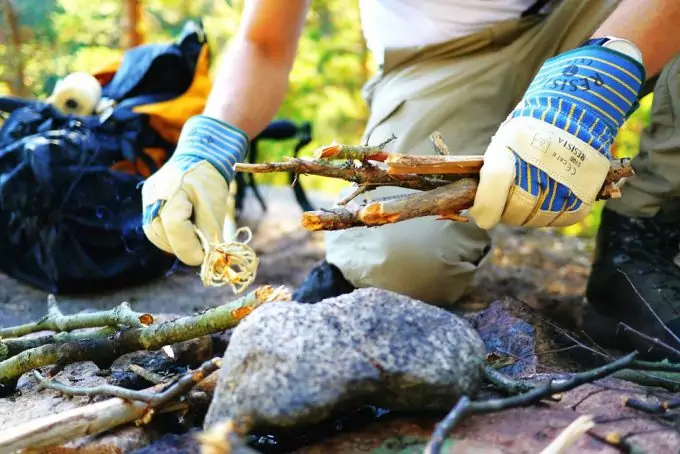
Additional fire starting techniques: if you have a camera or binoculars, you can use the lens on the devices in order to start a fire naturally with the sun. Once the tinder you are using begins to smoke, you can feed the fire by gently blowing on it until it starts up. In addition, you have the option of creating a fire plow where you cut out a groove into a piece of soft wood. You put tinder at one end of the groove you cut and rub a stick inside the groove until a spark sets the tinder on fire.
Establish a shelter
One easy way to establish an outdoor shelter involves bending a sapling over and tying it down with either a rope or vines. Once the sapling is secure, you can gather branches from pine trees, other saplings, sticks with leaves, and create a roof. Make the sapling the base for a lean to, and put large sticks along each side so can build up the shelter.
You will need branches and twigs in whatever size you can muster. Make sure you use dry tinder to make the shelter insulation. If you happen to be outdoors lost in snowy conditions, you can dig a hole in deep snow or build a shelter out of snow fairly quickly. Snow is an outstanding natural insulator.
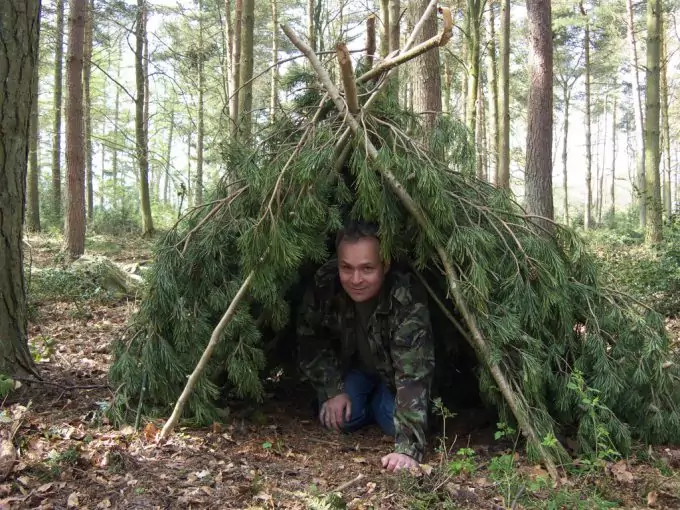
You need to establish somewhere to sit and/or lay down too. You should never put your body against the earth, especially to sleep. The earth is cold and will cause your body temperature to drop. While being on the ground for a short period is acceptable, lying on the ground for hours can prove incredibly dangerous and you run the risk of becoming hypothermic. You can establish some bedding by using moss, leaves, and branches so you can keep your body up off the cold ground.
If it is extremely cold, you can use a pile of dried leaves to keep warm as well. When gathering leaves, make sure you do not accidently scoop up leaves that are poisonous, like poison ivy.
Weaponry
In absence of a knife, you are going to need some kind of weapon, first for getting food, and second, for your own protection. You can make a sharp instrument to work with by taking one rock and striking it against another. You must continue to do this until different pieces of the rock break off and leave behind a sharpened edge. Make sure the two rocks you use are different types of rocks.
If you use similar rocks to strike each other, the rocks are less likely to chip off and leave sharp fragments. If you have a knife on you, you can make a spear by sharpening the end of a large stick as well. In lieu of sharp weapons, you can use rocks to throw at predators, and sometimes you can use the rocks to kill small animals and snakes for a food source as well.
Food sources
After your water source discovery, fire building, and establishing a safe shelter, it is time to look for food. There are many things you can eat when you are out in the woods in an emergency situation. While some foods sources might not seem pleasant, they will keep you alive until you are found. Your emergency food options include fish, frogs, crawfish, snakes, night crawlers, grubs, and small animals like rabbits and squirrels.
Some berries are edible, but if you are not, sure about what kind of berries you are dealing with you should refrain from eating them at all, as some berries are poisonous. When it comes to wild mushrooms, at no time should you consume them. Read our post on how to recognize wild plants that are edible for more information.

You can also chestnuts and water chestnuts if you can find them. Use a rock to crack open the chestnuts to reveal the food inside. Water chestnuts are not actually nuts, but they have a fleshy material inside that you can consume boiled or raw. If it is not snowing, you can look for wild strawberries, blackberries, and raspberries as well. Queen Anne’s lace flowers offer up wild carrots when you pull up the roots, but only the young roots will prove edible.
[the_ad_placement id=”in-text-3-type-r”]There is also an opportunity to seek out wild onions. Just remember, never, ever consume any food source you are uncertain of, and if possible cook the food you are going to consume. Do not eat raw fish or meat. See our article on edible insects that can help you survive in the woods.
Finding help
If you locate a stream when you are lost in the woods, make sure you move downstream to look for help. As you move downstream, you are eventually going to encounter a larger body of water and there is a greater chance that is where you will find civilization. You should not go looking for help until you are sure that no one is coming to rescue you. You may have rescuers looking for you, and you will be easier to find if you remain in one place. For ways on how to make a DIY water filter in the wilds, read our article for more safety tips.
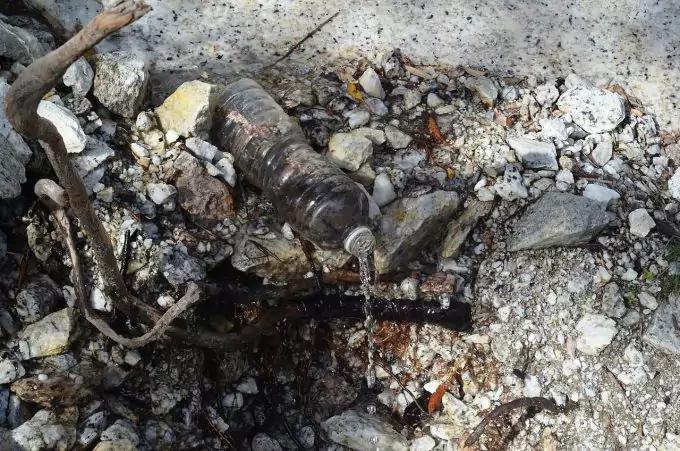
If you decide to travel to look for help, do not move during nighttime hours. Instead, do all of your search and travel during the day, and preferably, when the sun is not at its highest point. As you are looking for a body of water, make sure you move through the woods in one direction only.
This is your opportunity to put on bright colored attire, to spell out the words help or SOS with large sticks or trees, and to do things to be noticed. If you have brought a mirror, you can use it to reflect sunlight and to cause a noticeable glare.
In closing
If you keep your cool and remain in control at all times, it is possible to survive being lost in the woods. You need to think clearly, assess your situation, and take the steps necessary to ensure you get water, shelter, and food as soon as it is possible to do so. If you plan ahead and bring a survival kit with you, the ease in which you will survive your ordeal will increase tenfold.
Nevertheless, even if you only have yourself and the wilderness, there are effective ways to survive being lost. Adults and children owe it to themselves to learn survival method – you never know when you might need them.


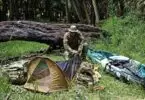

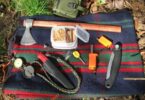

To be lost in the woods is a living nightmare. It’s the worst thing in the world that could possibly happen to a hiker.
When I was fourteen, I went to the woods with a friend and we got lost. It was the worst feeling in the world, I was scared and hungry, and felt so alone, even though my friend was with me. Help didn’t arrive until early morning and that night was the worst night in my life!
Hi Frank,
That was unfortunate, but you should learn from this experience that preparation is key to survival.
I always tell my friends and family members where I am going. If they know of my whereabouts and I get lost, they can notify the authorities and they can launch a search party in the region I am actually in.
Thank you brad for sharing your opinion with us.